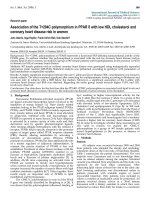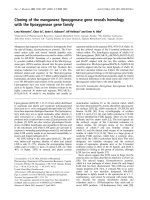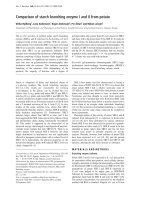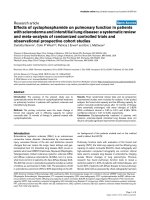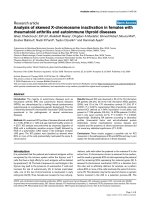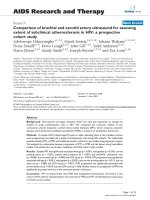Báo cáo y học: " Comparison of visual and objective quantification of elbow and shoulder movement in children with obstetric brachial plexus palsy" docx
Bạn đang xem bản rút gọn của tài liệu. Xem và tải ngay bản đầy đủ của tài liệu tại đây (235.74 KB, 6 trang )
BioMed Central
Page 1 of 6
(page number not for citation purposes)
Journal of Brachial Plexus and
Peripheral Nerve Injury
Open Access
Research article
Comparison of visual and objective quantification of elbow and
shoulder movement in children with obstetric brachial plexus palsy
Andrea E Bialocerkowski* and Mary Galea
Address: Rehabilitation Sciences Research Centre, School of Physiotherapy, The University of Melbourne, VIC, 3010, Australia
Email: Andrea E Bialocerkowski* - ; Mary Galea -
* Corresponding author
Abstract
Background: The Active Movement Scale is a frequently used outcome measure for children with
obstetric brachial plexus palsy (OBPP). Clinicians observe upper limb movements while the child is
playing and quantify them on an 8 point scale. This scale has acceptable reliability however it is not
known whether it accurately depicts the movements observed. In this study, therapist-rated Active
Movement Scale grades were compared with objectively-quantified range of elbow flexion and
extension and shoulder abduction and flexion in children with OBPP. These movements were
chosen as they primarily assess the C5, C6 and C7 nerve roots, the most frequently involved in
OBPP. Objective quantification of elbow and shoulder movements was undertaken by two-
dimensional motion analysis, using the v-scope.
Methods: Young children diagnosed with OBPP were recruited from the Royal Children's
Hospital (Melbourne, Australia) Brachial Plexus registry. They participated in one measurement
session where an experienced paediatric physiotherapist facilitated maximal elbow flexion and
extension, shoulder abduction and extension through play, and quantified them on the Active
Movement Scale. Two-dimensional motion analysis captured the same movements in degrees,
which were then converted into Active Movement Score grades using normative reference data.
The agreement between the objectively-quantified and therapist-rated grades was determined
using percentage agreement and Kappa statistics.
Results: Thirty children with OBPP participated in the study. All were able to perform elbow and
shoulder movements against gravity. Active Movement Score grades ranged from 5 to 7. Two-
dimensional motion analysis revealed that full range of movement at the elbow and shoulder was
rarely achieved. There was moderate percentage agreement between the objectively-quantified
and therapist-rated methods of movement assessment however the therapist frequently over-
estimated the range of movement, particularly at the elbow. When adjusted for chance, agreement
was equal to chance.
Conclusion: Visual estimates of elbow and shoulder movement in children with OBPP may not
provide true estimates of motion. Future work is required to develop accurate, clinically-acceptable
methods of quantifying upper limb active movements. Since few children attained full range of
motion, elbow and shoulder movement should be monitored and maintained over time to reduce
disability later in life.
Published: 01 December 2006
Journal of Brachial Plexus and Peripheral Nerve Injury 2006, 1:5 doi:10.1186/1749-7221-1-
5
Received: 23 June 2006
Accepted: 01 December 2006
This article is available from: />© 2006 Bialocerkowski and Galea; licensee BioMed Central Ltd.
This is an Open Access article distributed under the terms of the Creative Commons Attribution License ( />),
which permits unrestricted use, distribution, and reproduction in any medium, provided the original work is properly cited.
Journal of Brachial Plexus and Peripheral Nerve Injury 2006, 1:5 />Page 2 of 6
(page number not for citation purposes)
Background
Obstetric brachial plexus palsy (OBPP) is a complication
of childbirth, which is characterized by one or more nerve
conduction blocks within the brachial plexus [1]. These
blocks range in severity and location within the plexus
and primarily affect the child's ability to move and effec-
tively use their affected upper limb [2]. Thus the quantifi-
cation of motor function is essential when assessing
children with OBPP [3].
The assessment of motor function in young children is
more difficult when compared with adolescents and
adults [4]. Young children often lack cooperation and
communication skills [5]. Thus they experience difficulty
following commands to move or maintain their limbs in
test positions for measurement [6]. Measurement of the
child's ability to move their affected upper limb is further
complicated by spontaneous, rapid movements that often
occur in infants and young children [7]. As such, in the
clinical setting active range of movement of the child's
affected limb is infrequently measured with a goniometer
or inclinometer. Rather it is facilitated by play, visually
estimated and usually quantified on a rating scale [8].
One such rating scale for the quantification of movement
in children with OBPP is the Active Movement Scale.
Developed by Clarke and Curtis [8] it evaluates overall
joint movements, such as shoulder flexion and elbow
extension, in positions where gravity is eliminated and
against gravity. Movement is quantified on an eight-point
ordinal scale, with 0 equating to "no contraction visible"
and 7 being "full motion" present (Table 1). This meas-
urement tool has moderate to excellent intra- and inter-
rater reliability when used by experienced clinicians on
children with OBPP between 1 month to 15 years of age
[4,9].
One advantage of using this rating scale is that is quanti-
fies movement in categories, such as "motion greater than
half range". This procedure theoretically produces less var-
iability in scoring and may provide higher reliability coef-
ficients and smaller measurement errors compared to
direct measurement of active movement [10]. However,
no comparison has been made between therapist-rated
Active Movement Scale grades and objectively-quantified
range of active movement. This is important to determine
as management decisions are based on Active Movement
Scale grades [3] and currently the accuracy of the Active
Movement Scale is not known. This study addressed this
gap in the evidence by comparing therapist-rated Active
Movement Scale grades with objectively-quantified range
of elbow flexion and extension and shoulder abduction
and flexion in children with OBPP. These movements
were chosen as they primarily assess the C5, C6 and C7
nerve roots, which are the most frequently involved in
OBPP [11]. Objective quantification of elbow and shoul-
der movements was undertaken by two dimensional
motion analysis, using the v-scope.
Methods
Data collection was part of a larger study which investi-
gated the intra- and inter-rater reliability of two-dimen-
sional motion analysis (using the v-scope [Eshed Robotics
Inc]) to quantify elbow and shoulder movement in young
children with OBPP. Detailed information regarding the
v-scope and the method of movement quantification can
be found in another publication [12]. Prior to the com-
mencement of the study, ethical approval was gained
from the Royal Children's Hospital, Melbourne, Australia
and The University of Melbourne, and consent was gained
from the participating families.
Participants
All families of children on the OBPP registry at the Royal
Children's Hospital, aged between six months and four
and a half years were eligible to participate in this study,
irrespective of their functional status, residential location
or method of management. Case notes were used to con-
firm the diagnosis of OBPP and to gather demographic
information about the child.
Objective quantification of active movement
The v-scope, a two-dimensional motion analysis system
was used to quantify the maximal range of elbow flexion
and extension and shoulder abduction and flexion. Its
three transmitting towers were configured in an L-shape
and they located the position of up to four "buttons"
which were placed by an experienced paediatric physio-
therapist on standardized landmarks on the child's
affected upper limb, trunk and chest. The location of these
"buttons" was based on a pilot study of 10 non-impaired
children. Each child was positioned on the floor in the
centre of the towers' fields at a distance of 1.5 meters from
the towers.
Table 1: The Active Movement Scale [15]
Observation Muscle grade
Gravity eliminated
• No contraction 0
• Contraction, no motion 1
• Motion ≤ 1/2 range 2
• Motion > 1/2 range 3
• Full motion 4
Against gravity
• Motion ≤ 1/2 range 5
• Motion > 1/2 range 6
• Full motion 7
Journal of Brachial Plexus and Peripheral Nerve Injury 2006, 1:5 />Page 3 of 6
(page number not for citation purposes)
The same, experienced paediatric physiotherapist facili-
tated the maximal range of elbow flexion and extension,
shoulder abduction and flexion through play or by tap-
ping the corresponding muscle group, according to the
procedures outlined by Curtis et al [9]. Three repetitions
of each of the movements were conducted in a standard-
ized order. This information was captured by the v-scope.
In addition, the same paediatric physiotherapist quanti-
fied each movement on the Active Movement Scale.
Data analysis
Demographic characteristics of the participants and the
maximal range of elbow flexion and extension, shoulder
abduction and flexion were summarised using descriptive
statistics. Data were extracted from the v-scope program
and exported into Microsoft Excel 2005. Angles that
depict the maximum range of elbow flexion and exten-
sion, shoulder abduction and flexion were calculated by
dot product from the vectors for adjacent segments, which
were gained from the X, Y and Z co-ordinates of the "but-
tons". This produced values, in degrees, for maximal
elbow flexion and extension, shoulder abduction and
flexion. Three maximal angles for each movement were
subsequently identified, averaged and used in all analyses.
As three Active Movement Scale grades were generated for
each direction of movement, the mode was used in all
analyses. Analyses revealed that the Active Movement
Score did not change between repetitions for any of the
movements.
To determine the accuracy of the therapist-rated Active
Movement Score grades for each direction of movement,
therapist-rated grades were compared with objectively-
quantified Active Movement Score grades. Objectively-
quantified Active Movement Score grades were generated
by collapsing the maximal angles gained by the v-scope,
measured in degrees, into the appropriate categories on
the Active Movement Scale. This required knowledge of
what constitutes half range of elbow flexion and exten-
sion, shoulder abduction and flexion. Normative values
described by Boone et al [13] were subsequently used as
they were established in children of a similar age group.
As range of motion is variable in subjects with "normal"
elbows and shoulders, "full motion" was defined as
motion that was greater than or equal to the lower 95%
confidence point of maximal range. This motion was
halved to determine the cut off point between grades of
movement, such as grade 5 (Motion ≤ 1/2 range) and
grade 6 (Motion > 1/2 range) (Table 2). Percentage agree-
ment and Kappa statistics, which correct for chance agree-
ment, were calculated to determine the agreement
between the two sets of Active Movement Scores [14]. All
analyses were conducted in Statistical Packages for Social
Sciences (SPSS) (Version 13). Where Kappa values could
not be calculated in SPSS, due to the lack of spread of data,
they were calculated by hand using the formula outlined
in Portney and Watkins [15].
Results
Our sample consisted of 30 children with OBPP (18
females, 12 males), aged between 0.6 and 4.6 years. Most
participants were diagnosed with a C5, C6 (43%) or C5,
C6, C7 (37%) nerve conduction block and few underwent
a primary nerve repair within the first year of life (n = 4).
None of the participants had undergone secondary shoul-
der or elbow surgery.
The average range of elbow flexion and extension, shoul-
der abduction and flexion is presented in Table 3. When
these values are compared to the norms in Table 2, it can
be seen that very few participants' movement could be
considered as "full" or "normal". Only five participants
gained what was considered "full motion" for elbow
extension, and none of the participants recorded "full
motion" for elbow flexion, shoulder abduction and flex-
ion. All subjects were able to perform the elbow and
shoulder movements against gravity. Thus their move-
ment was graded as 5, 6 or 7 on the Active Movement
Scale.
Table 4 illustrates the frequency of therapist-rated and
objectively-quantified Active Movement Scale grades.
There was moderate percentage agreement in Active
Movement Scale grades, which ranged from 41% (elbow
Table 2: Normative values and cut off points for conversion of angular into Active Movement Scores
Active Movement Score cut-offs
Direction of movement Norm* – Maximal range (95% CI) Motion ≤ 1/2 range Motion > 1/2 range Full motion
Elbow flexion 145.4° (144.0°–146.8°) ≤ 71.1° 71.2–143.9° ≥ 144.0°
Elbow extension 0.6° (0.1°–1.7°) ≥ 71.2° 1.8°–71.1° ≤ 1.7°
Shoulder abduction 185.4° (184.4°–186.4°) ≤ 92.1° 92.2°–184.3° ≥184.4°
Shoulder flexion 168.4° (167.4°–169.4°) ≤ 83.6° 83.7–167.3° ≥ 167.4°
* Boone et al [13], CI confidence interval
Journal of Brachial Plexus and Peripheral Nerve Injury 2006, 1:5 />Page 4 of 6
(page number not for citation purposes)
flexion) to 70% (shoulder flexion). When this was cor-
rected for chance agreement, agreement was equal to
chance. Movement was most frequently over-estimated by
the paediatric physiotherapist, at the elbow more than at
the shoulder.
Discussion
This is the first known study that has compared therapist-
rated Active Movement Scale grades with objectively-
quantified active range of elbow flexion and extension
and shoulder abduction and flexion in children with
OBPP. We found that there was little agreement in the
muscle grades, with the paediatric physiotherapist most
frequently over-estimating the movement gained. This
discrepancy was most apparent between grades 6 and 7,
when the therapist graded the movement as "full motion"
(grade 7) when it was less than what is considered full
movement in children with "normal" elbows and shoul-
ders. This more frequently occurred at the elbow rather
than at the shoulder.
Overestimation of range of elbow flexion and extension
may have occurred due to error in interpreting what con-
stitutes half range at this joint. Ninety degrees of flexion at
the elbow tends to be easy to visualize as the forearm is
horizontal when the subject is in the sitting position [16].
This is often what is thought to guide the quantification of
range of movement at the elbow. However, 90° of elbow
flexion does not represent half range of motion as full
motion of the elbow is typically 140°–150° [13,17]. Thus
it may be difficult to judge when the elbow is at 70°,
which is 20° before the forearm is horizontal. This is in
contrast to the shoulder, which has 165°–185° of flexion
or abduction [13,18]. Half range of motion is at approxi-
mately 90° of flexion or abduction, ie when the forearm
is in the horizontal position.
Our choice of norms may also have contributed to the
lack of agreement between the two sets of Active Move-
ment Scale grades. Currently, there is little evidence
regarding what is "normal" range of movement at the
elbow and shoulder in young children. One hundred and
twenty degrees has been used as "normal" range of move-
ment at the elbow by clinicians treating children with
OBPP [19]. However there is no evidence to support this
contention. In this study, we used Boone et al's [13]
norms, as they were developed on a sample that most
closely matched the one used in this study. Despite this,
there were differences between the two samples and meth-
odologies that should be considered when interpreting
Table 3: Range of elbow and shoulder movement in children with obstetric brachial plexus palsy
Direction of movement Mean (95% CI) Range n
Elbow flexion 115.2° (108.1–122.3°) 69.7°–143.3° 29
Elbow extension 10.5° (6.6°–14.4°) 1.0°–52.0° 30
Shoulder abduction 116.7° (108.1°–125.3°) 62.3°–158.3° 27
Shoulder flexion 138.2° (135.1°–141.3°) 116.7°–157.0° 30
CI confidence interval, n number of participants
Table 4: Comparison of the therapist-rated and objectively-quantified Active Movement Score grades
Frequency Agreement
Direction of movement Active Movement Scale Grade Therapist-rated Objectively-quantified % agreement Kappa
Elbow flexion 5 3 1
6132841-0.05
7130
Elbow extension 5 0 0
6 10 25 43 0.07
7205
Shoulder abduction 5 5 4
61723560.0
750
Shoulder flexion 5 3 0
62130700.0
760
Journal of Brachial Plexus and Peripheral Nerve Injury 2006, 1:5 />Page 5 of 6
(page number not for citation purposes)
our results. For example, 1–19 year old males were used in
Boone et al's [13] study, compared with 0.5–4.6 year old
children (18 female, 12 male) in the present study. Range
of movement decreases with age [13,18] and females tend
to have greater range of movement compared with males
[18]. However it is not known whether these changes take
place before or after puberty or later in life. Although
hand dominance does not to influence shoulder move-
ment, Gundal et al [17] found that there were significant
differences in elbow movement between the right and left
sides (differences of approximately 2°). Boone et al [13]
did not produce left and right sided norms for the elbow
and shoulder.
A hand-held goniometer was used to produce the norms
by Boone et al [13]. This measurement tool may have a
greater measurement error compared to using two-dimen-
sional motion analysis to quantify elbow and shoulder
movement in young children. Measurement error for the
v-scope (2× standard error of measurement) was less than
15° [12]. However measurement error for hand-held
goniometry in young children has not been established.
Considering the rapid, spontaneous upper limb move-
ment in young children, measurement error may be con-
siderable in this population [7]. Thus future studies are
required to determine the range of "normal" elbow and
shoulder movement in young children using various
methods, which are feasible to use in the clinical setting.
Despite these limitations, it is acknowledged that there is
error associated with all types of measurements. However,
the aim of clinical measurement is to reduce this error as
much as possible during assessment and to consider the
degree of measurement error when interpreting the results
[15]. Developers of the Active Movement Scale sought to
reduce variability in scoring by quantifying movement in
categories [8]. Although this is theoretically sound [10],
the Active Movement Score grades may not represent true,
objectively-quantified movement at the elbow and shoul-
der. Thus, future work is required to develop accurate,
clinically acceptable methods of quantifying upper limb
active movements.
We also found that children with OBPP rarely gain full
range of elbow flexion and extension, shoulder flexion
and abduction. Lack of elbow and shoulder range of
movement may compromise the ability to perform daily
tasks [20]. Since range of shoulder and elbow movement
decrease with age [13,18] and the symptoms of OBPP are
exacerbated with age and produce increasing disability
[20], our results provide a justification to monitor and
maintain upper limb movement in children, adolescents
and adults with OBPP.
Conclusion
The main finding of this study is that visual estimates of
elbow and shoulder movement in children with OBPP
may not provide true estimates of motion. Since decisions
regarding the optimal management strategies, including
whether surgery is indicated, are often made based on this
type of assessment, clinicians should interpret their results
with care. Moreover future work is required to develop
accurate, clinically-acceptable methods of quantifying
upper limb active movements. A secondary finding was
that few children attained full range of motion. Hence,
elbow and shoulder movement should be monitored and
maintained over time to reduce disability in adolescence
and adulthood.
Competing interests
The author(s) declare that they have no competing inter-
ests.
Authors' contributions
AB participated in the study design, preparation of the
ethics application, trained research assistants, monitored
the project for quality, entered data, data analysis and
manuscript preparation. MG participated in the study
design, preparation of the ethics application and writing
of the manuscript.
Acknowledgements
This project was funding by a National Health and Medical Research Coun-
cil Health Professional Training Fellowship and an Early Career Researcher
Grant from The University of Melbourne for Dr Andrea Bialocerkowski.
The authors thank Mr Tim Wrigley, Director, Movement Research Labo-
ratories, Centre for Health, Education and Sports Medicine, School of Phys-
iotherapy, The University of Melbourne, for his assistance with the two-
dimensional motion analysis. Ms Lana Tinsely, who assisted with recruit-
ment of the participants, and Ms Jennifer McCahill, who collected the data,
are also acknowledged.
References
1. Birch R: Obstetric brachial plexus palsy. J Hand Surg 2002,
27B:3-8.
2. Van Dijk GG, Pondaag W, Malessy MI: Obstetric lesions of the
brachial plexus. Muscle Nerve 2001, 24:1451-1561.
3. Van Ouwerkerk WJR, van der Sluijs JA, Nollet R, Barkhof F, Sloof
ACJ: Management of obstetric brachial plexus lesions: state
of the art and future developments. Child's Nervous System 2000,
16:638-644.
4. Bae DS, Waters PM, Zurakowski D: Reliability of three classifica-
tion systems measuring active motion in brachial plexus
birth palsy. J Bone Joint Surg 2003, 85A:1733-1738.
5. Ramos LE, Zell JP: Rehabilitation program for children with
brachial plexus and peripheral nerve injury. Semin Paediatr Neu-
rol 2002, 7:52-57.
6. Waters PM: Comparison of the natural history, the outcome
of microsurgery and the outcome of operative reconstruc-
tion in brachial plexus birth palsy. J Bone Joint Surg 1999,
81A:649-659.
7. Brazelton TB: Neonatal Behavioural Assessment Scale London: Blackwell
Scientific Publications Limited; 1984.
8. Clarke HM, Curtis CG: An approach to obstetrical brachial
injuries. Hand Clinics 1995, 11:563-581.
Publish with BioMed Central and every
scientist can read your work free of charge
"BioMed Central will be the most significant development for
disseminating the results of biomedical research in our lifetime."
Sir Paul Nurse, Cancer Research UK
Your research papers will be:
available free of charge to the entire biomedical community
peer reviewed and published immediately upon acceptance
cited in PubMed and archived on PubMed Central
yours — you keep the copyright
Submit your manuscript here:
/>BioMedcentral
Journal of Brachial Plexus and Peripheral Nerve Injury 2006, 1:5 />Page 6 of 6
(page number not for citation purposes)
9. Curtis C, Stephens D, Clarke HM, Andrews D: The active move-
ment scale: an evaluative tool for infants with obstetrical
brachial plexus palsy. Hand Clinics 2002, 27A:470-478.
10. Guyatt GH, Townsend M, Berman LB, Keller JL: A comparison of
likert and visual analogue scales for measuring change in
function. J Chronic Dis 1987, 12:63-66.
11. Waters PM: Update on management of pediatric brachial
plexus palsy. J Pediatr Orthop 2005, 25:116-126.
12. Bialocerkowski AE, Wrigley T, Galea M: Reliability of the meas-
urement of arm movement in children with obstetric bra-
chial plexus palsy. Develop Med Child Neurol 48:913-917.
13. Boone DC, Azen S: Normal range of motion of joints in male
subjects. J Bone Joint Surg 1979, 61A:756-759.
14. Landis JR, Koch GG: The measurement of observer agreement
for categorical data. Biometrics 1997, 33:59-174.
15. Portney LG, Watkins MP: Foundations of clinical research: applications to
practice 2nd edition. Prentice-Hall Health: New Jersey; 2000.
16. Cambridge-Keeling CA: Range of motion measurement of the
hand. In Rehabilitation of the Hand: Surgery and Therapy 4th edition.
Edited by: Hunter JM, Mackin EJ, Callahan AD. St Louis: Mosby;
1995:93-107.
17. Gunal I, Kose N, Erdogan O, Gokturk E, Seber S: Normal range of
motion of the joints of the upper extremity in male subjects
with special reference to side. J Bone Joint Surg 1996,
78A:1401-1404.
18. Barnes CJ, Van Steyn SJ, Fischer RA: The effects of age sex and
shoulder dominance on range of motion of the shoulder. J
Shoulder Elbow Surg 2001, 10:242-246.
19. Basheer H, Zelic V, Rabia F: Functional scoring system for
obstetric brachial plexus palsy. J Hand Surg 2000, 25B:41-45.
20. Partridge C, Edwards S: Obstetric brachial plexus palsy: increas-
ing disability and exacerbation of symptoms with age. Physi-
other Res Internat 2004, 9:157-163.
